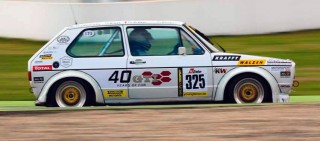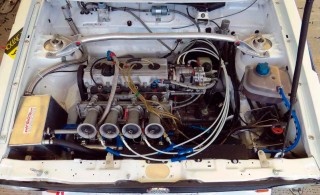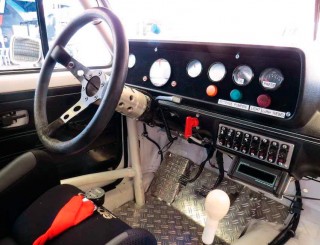Where are we going with this? Well, back in 1980 the chiefs at VAG France had a bit of a sweat on. With the Renault 5 Alpine, Escort XR3 and Lotus Sunbeam all launched, the competition was catching up and the 1.8-litre 8v Mk1 GTI couldn’t come quick enough. Instead of waiting, they roused Wolfsburg engineers and commissioned a short run of twin-cam-head converted ‘16S’ models for the French and Swiss market to keep ahead of the game. Launched by German company, Oettinger at the Frankfurt Motor Show in 1977, the actual head design waited four years from those early prototypes, during which time it had been discretely tested in various cars, rumoured to include the Kamei Mk1 Golf – possibly the most identifiable Mk1 racer every made. Head R&D done, and sitting atop the 1.6-litre EG block, these Gallic-shrug 16S road-going, factory-warranted GTIs, with 136bhp (up from the 8v’s 110bhp), went on sale in late 1981.

Bon! Break out the Beaujolais Nouveau and brie. And we all know what happens when specials like this are made: they get raced. Over a thousand 16Ss was easily enough to get the Group 4 paperwork stamped in December 1981 with the suits at the FIA, and the twin-cam Rheilaliveried Oettinger Mk1 GTI rally car sits in the Wolfsburg museum as a testament to that.
But this feature isn’t actually about road cars or rally cars. Gracing these pages is the out-and-out racing version, sitting in a 1977 chassis with nearly sixty percent more power than the original GTI – and all the hardcore period tuning niceties and naughtiness you could possibly imagine.
This stunning Group 4-spec Mk1 was obviously far out of the ordinary when it debuted back in 2011. Originally created for the Golf GTI 35-year celebrations and rolled out at the Wörthersee Treffen that year, this car is not a replica of any previous racer from back in the day. It was commissioned specially by VW, and established tuners KWL Motorsport built it for them. Headed up by Rolf Krogel, KWL is, in fact, an “Official partner of Volkswagen AG” and helps with the running of its historic Volkswagen Motorsport fleet. As if to prove the point, many Dub nuts are at least loosely aware of the twin-engined Mk2 Golfs used at Pikes Peak in the ’80s. Talking about the surviving 1987 car, Rolf mentioned: “In 2008 we have completely made new [restored] the Pikes Peak Golf.” Based in Burscheid on the western side of Germany, they’ve been an independent tuner since opening for business in 1978 – and there isn’t a thing these guys don’t know about tuning these original water-cooled Volkswagens.

Wörthersee and show-appearances aside, the car’s true purpose was only ever to go fast. One glance under the steel bonnet of this retro throwback blows the doors of any stray ideas that this could be a big fancy dress, kitted and ready for a season of show proms. When did you last see an Oettinger 16S engine running through a set of ITBs? Not often, that’s for sure.
Since that unveiling in 2011, this Mk1’s been raced hard by drivers Patrick Simon, Heinz Stüber and Klaus Niedzwiedz. Sticker bombing is de rigueur in this game too; various window and roll cage stickers attest that it’s been raced in historic events at circuits throughout Europe. Its CV soon included a class win at the so-called Nürburgring 24-Hour ‘Classic’ Youngtimer Trophy event – three hours of retro racing action ahead of the modern round-the-clock marathon. Then it visited the Goodwood Festival of Speed for the first time in 2011, piloted up the hill by former F1, DTM and two-time Le Mans 24 Hours winner, Hans Joachim Stuck, plus there was the Techno Classica Essen Motor Show in 2012, where Volkswagen Motorsport put on a huge display. Re-liveried in 2016 for the Golf GTI 40-year celebration, the Mk1 was back at the Goodwood Festival of Speed mid-year, again driven by Hans Stuck, accompanied by the newly-released Mk7 Golf GTI Clubsport S and polar-opposite, four-time- champion-elect Polo R WRC.

Checking out the 2016 silverware list shows it isn’t getting any slower either: Hockenheim (first in class), Racing Days Assen (second overall), winning its class again at Zaandvoort (with 4th and 6th overall) and first in class at the season’s final race, on the legendary Nürburgring Nordschleife. This Mk1 is on top of its game.
Dub Archery
From day one, what stood out about this Golf is how it just looks and sits so right. It hits the ground running on a set of 8.5×15” gold magnesium-centred BBS E76s covered in no-nonsense 205/580 Avon race rubber.
As the numbers of track and road-racer Mk1s have climbed in recent years, Berg Cup-style cool has more than established a modifying genre in its own right. With an FIA Group 2-spec arch kit on this car (widely nick-named ‘Berg Cup’ on account of conspicuous use in the aforementioned Euro hill climbing series) it differs subtly from the standard fare. “In former years, it was from Zender,” explained Rolf with his Germanic twang. “We have it made new, a little bit better for fitting on the car. And also [we have made] the Golf Mk2 Group 2 kit now,” before Rolf reached for his phone pictures. With a squarer front spoiler and an extended trailing rear arch profile, this gives the car a sleeker look. These are small changes, but in keeping with the historic theme. ‘Tubbed’ outer rear arch modifications raise the lips before the KWL kit is fitted.

The Oily Bits
Under the bonnet sits a full Group 4-spec, 1.6-litre Oettinger 16-valve motor in all its glory. “The Oettinger motor, the best,” smiles Rolf. Conventional 1588cc GTI bore and stroke dimensions are retained, but there the similarities start to end. The beast is fed air through four trumpets, with the bonnet skeleton clearanced to fit, then into a sliding throttle plate rather than butterfly – and fuelled with the period ‘Kugelfischer Einspritzpumpe’, aka the mechanical fuel-injection pump. This imposing device is cam-driven off the side of the head next to the finned Oettinger cam cover, and operated by a rose-jointed set-up piggy backed to the throttle cable. The bespoke feel continues with the hall marks of race builds: curious numbers stamped in the head, cam cover, and injection pump, all telling a tale of hand-built unique identifiers. Aside from the clear injection hoses, there are braided hoses everywhere.

Bonus Oettinger geek points for spotting the four water-cooling feeds through the inlet manifold into the head, replicating the cooling seen in a ‘normal’ road-going Oettinger inlet plenum. ‘Normal’ is a relative thing, because while eBay sees this gear pop up every so often, this racing business amounts to a higher grade of VW scene cocaine and even the former catalogue-listed water-jacketed inlet manifold version doesn’t exist for throttle bodies. “We have made the inlet manifold, we also have made the exhaust manifold parts and so on. If you can’t buy it, you have to recreate it. If you can spend the time and the money doing it, it’s great,” noted Rolf. Camshafts made by Schrick – in conjunction with KWL – to 314-degree duration open and close the aforementioned ‘Soupapes’, timed up with an obligatory vernier adjustable cam wheel.
High-revving race engines – this one spins to a giddy 9000rpm – mean breather systems often get pushed beyond road-going limits, with the quantity of air and oil vapour pumping around an engine. So a cam cover breather relieves the pressure into the inner-wing mounted aluminium tank, as well as a pipe from the crankcase itself. Then the large alternator pulley down-gears the alternator speed to stop it over charging.

A quick glance underneath reveals, almost surprisingly, not a two-piece Oettinger sump, but a period, finned aluminium Hör Technologie version. Considered by some the best available at the time, it’s got trap doors inside to provide a continuous oil supply. Nestling inside the 1.6- litre block are the best rods allowed for this regulation spec: “Ingolstalt rods,” as Rolf puts it, from an Audi 80 GTE, while high-comp pistons are made by Wiseco from KWL’s drawings. So what power does all this add up to? KWL quote in ‘Euros’: 215PS (approximately 212bhp). Hmmm… 132bhp per litre with just 800kgs to push around means only one thing: wide smiles.
You get the picture: it’s all sheer, unadulterated purpose, aside from the comedy sink plugs and chains, to keep flying chewing gum out of the inlets while the bonnet’s up and in show mode. It’s even raced without an air box or filters. Sounds all a bit passé, but standard fare for the historic race paddocks, full of motors high on output, but low on race mileage.
Volkswagen of course didn’t follow through with this 16v head when they created the Mk2 GTI 16v, nicking a head instead which was essentially one half of the original 3.6-litre Audi V8, all of which means there was only ever a rumoured 1250 Mk1 16S engines with this Oettinger head produced, plus Mk1 and Mk2 1.6- litre to two-litre conversions sold separately. Safe to say, the well-invested collectors are now deep into their own field day. With standard Oettinger units changing hand for well into five figures, the mind boggles as to what’s sat here, and of course it’s all completely built in-house at KWL.
Cog Swapping

The Hör Technologie theme continues with the neighbouring rod-change five-speed VW Motorsport racing gearbox. Operated by an extended gear lever and a rose-joined linkage to replace the iffy OEM plastic set up, it contains a part-helical, part-straight-cut synchromesh gear set. Rolf explained it was a special item that was homologated only for Oettinger and it has in it a 5th gear ratio of 1.21. So a motorway cruiser this is not! With that straight-cut fifth gear and a 4.22:1 final drive, compared with regular 1.6- litre Mk1 GTI’s 0.91:1 and 3.89:1, the glaring differences stand out. This is far and away from standard, designed purely to accelerate very fast between the corners, and arrive hanging onto dizzying rpms before the homologated four-pot Girling front calipers with 280mm discs (and Mk2 Golf 239mm rears) calm it all down. Yes, even the unicorn-status twin-pot VW Motorsport rear brake set up eludes KWL. Also in place of the traditional Hör Technologie ‘Gleitsteinsperre’ diff locker sits a special order limited-slip differential from Drexler, which keeps the power channelling through both driveshafts regardless of traction. Away from the complexity and unobtanium hardware expense, a simple fabricated retaining strap over the familiar 020 green gearbox endcasing shrieks ‘race experience’: the seasoned KWL team aren’t going to fall for a silly DNF result – and gearbox oil all over the left hand wheel arch – thanks.
OCD Prep

Just as it is with show, winning when racing is about the finer details too, but detailing here is a different ball game. Hand-built cars with uprated engine mounts shake nuts and bolts loose for shits and giggles. So this Golf’s covered in paint marks on most of its fixings which tell a story of mechanics carefully checking torques, and eyeballing for any movement before next turning a wheel in anger. Tying anything down which could cause reliability issues, preparation is indeed the name of the game without which uncertainly awaits at the track. As they say, ‘the winning is all done in the garage’, as is allconsuming knowledge once the flag drops: the team know the car will run track stints for around one-and-a-half-hours before the 80-litre endurance fuel tank needs refuelling – and making sure it finishes a race without excess weighty fuel in it.
With the front and rear bumpers long gone, Mk2 Golf indicator repeaters sit in the blankedoff front bumper attachment holes, and one windscreen wiper has gone west in the single blade conversion. Finally, mesh covers the front panel holes to stop stones bulleting through the radiator from race track tailgating.
Sitting comfortably?
Suspension-wise, the KW two-way adjustable competition damper set up is rose-joint-mounted top and bottom (front and rear respectively), and notably works without any anti-roll bars. Optimised roll centre geometry, seam-welded front wishbones, racing bushes and toe change-minimising VW Motorsport Mk1-spec back axle – straight out of the FIA homologation papers – show there’s little in the way of stones unturned.
In the operations room sits a nothing-over-the- top six-point cage, a Cobra seat from ISA Racing with additional Sparco padding, TRS harness, and a very well-used Momo suede wheel. Behind it, a flock-fronted early dash with minimal distractions, and a Stack rev counter inlay with the obligatory 52mm VDO gauges to the right: fuel level, water plus oil temp and oil pressure with warning lights below. A row of pop-out circuit breakers replace the ash tray and bin-off the need for changing fuses, while tucked below is a cheeky, modern Zeitronix wideband lamda, bringing in modern tech to keep a beady eye on any wayward exhaust air-fuel ratios. An AP Racing brake-bias adjuster is mounted in the old handbrake lever frame, while a line lock behind this ensures the car remains in the paddock where the team left it. With the engine bay scuttle cut out and sealed up, the all-important heater for visibility in any conditions sits relocated under the dash.
Feel the Buzz
For all the advancement of modern turbocharged racing GTIs, this pleasingly old-school VW hot rod fizzes the mind, not at ultimately how fast it is, but how much fun is to be had. Clearly a riot and far more roller-skate involving than any modern force-fed uber-powered road-going Golf ever could be, it’s true to the ethos of going fast, looking good – and with the best oily parts and none of the fat.
Reflecting on our sea of modern-day chip tuning and ECU flashery, the words ‘old school’ are seemingly forever, refreshingly, echoing round the mind at the privilege of giving this very proper Mk1 a thorough once-over. Needless to say the 16S road cars are like hen’s teeth now. It wouldn’t be impossible to recreate this racer but you’d have a hell of a job finding all the bits to do it all. Chances are you’ll end up speaking with Herr Krogel!
One thing that will ‘busy up’ the purists: the Golf 16S didn’t come with small, pre-1980 rear lights albeit totally within the rules. But then that’s just the tip of the iceberg in historic racing. The cars may be built to a throwbackspec, but these guys are racers at heart. Tyres, oils, brake pads technology, double adjustable suspension, prep standards, cage, seats and harnesses – everything has moved on. In fact, they’re all faster and different in so many subtle ways to the original days, none of which detracts from the sense of occasion of roaring historic grids full of time-warp shapes and noise.
With the eclectic selection of competition and track-going cars of all types gracing the pages of PVW from time to time, this terribly pukka performance VW c’est formidable!
Shout: KWL Motorsport: www.kwl-motorsport.de (Facebook: KWL Motorsport) Volkswagen Classic: www.volkswagen-classic.de (Facebook: classicparts) Youngtimer Trophy: www.youngtimer.de (Facebook: youngtimertrophy)
Cage is purposeful without being over the top in either size or structure. Like everything else on the car, function comes before form.
Racing fuel cell lives beneath hinged firewall in rear floor.





